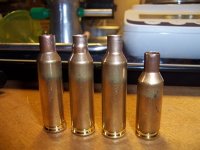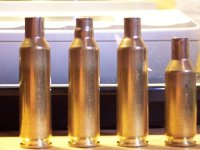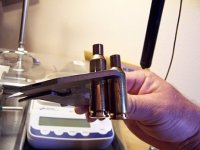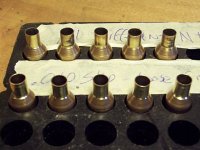I don't know that I agree with Jackie on the one-piece die being BETTER but I went and measured to find that on a custom-fitted die the shoulder DOES engage to act as a guide soon after the neck starts being sized. When the neck enters the sizing portion of a one-piece die THE CASE ISN'T SUPPORTED in the 7 chamberings I checked, but it engages quite soon. This is only true of those cases which have been designed with minimum taper, typical BR cases fit this description.
I have no trouble at all maintaining under .001 runout with bushing dies, Jones dies, One-piece dies from Redding, Forster and RCBS as well as custom made..... And I'll disagree seriously with anyone who believes that "eccentricity of the die" or "cheapo dies" ever causes crooked ammo. I'd like to have someone describe for me the machining method which results in a "crooked sizing die".
CHetahmans problem is that his neck is too big, his die doesn't fit his gun or his brass is improperly fireformed. All the support in the world can't account for improper fit and all the sizing in the world can't fix brass that's been formed crooked. And all the "alignment" in the world can't fix crooked brass. And a neck that's more than a thou or two over the brass simply cannot be maintained straight. Especially not while squeezing it down for .003 interference fit......
Straight brass is necessary for good aggs. Fitted necks are typically just a given on this board but I suspect thet CHeetahman's necks aren't.
al
I have no trouble at all maintaining under .001 runout with bushing dies, Jones dies, One-piece dies from Redding, Forster and RCBS as well as custom made..... And I'll disagree seriously with anyone who believes that "eccentricity of the die" or "cheapo dies" ever causes crooked ammo. I'd like to have someone describe for me the machining method which results in a "crooked sizing die".
CHetahmans problem is that his neck is too big, his die doesn't fit his gun or his brass is improperly fireformed. All the support in the world can't account for improper fit and all the sizing in the world can't fix brass that's been formed crooked. And all the "alignment" in the world can't fix crooked brass. And a neck that's more than a thou or two over the brass simply cannot be maintained straight. Especially not while squeezing it down for .003 interference fit......
Straight brass is necessary for good aggs. Fitted necks are typically just a given on this board but I suspect thet CHeetahman's necks aren't.
al
Last edited:





